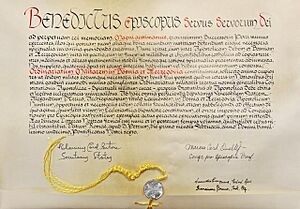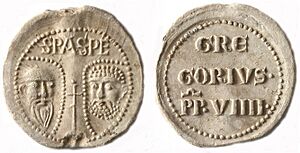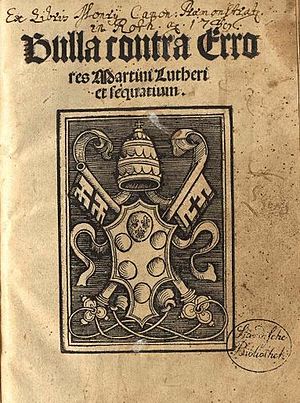Papal bull facts for kids
A papal bull is a very important official letter or announcement from the pope, who is the leader of the Catholic Church. It gets its name from the special lead seal, called a bulla, that was traditionally attached to the document. This seal was used to show that the letter was real and official.


Contents
History of Papal Bulls
Papal bulls have been used for a very long time, at least since the 500s. However, the name "papal bull" wasn't commonly used until the late 1200s. By the 1400s, it became the official name for these documents.
In the past, papal bulls were often used to confirm who owned property or to protect religious places like monasteries. This was important because it helped prove that a document was real, especially if the original papers were lost.
Since the 1100s, papal bulls have had a lead seal showing the heads of Saint Peter and Saint Paul on one side. The other side of the seal had the pope's name.
Originally, these documents were written on papyrus, a type of paper from ancient Egypt. But around the 1000s, they started using parchment, which is much stronger and lasts longer.
Today, papal bulls are used only for the most serious and formal announcements from the pope. In these documents, the pope still calls himself "Bishop, Servant of the Servants of God."
How Papal Bulls Looked
A papal bull used to start with a special line written in tall, stretched-out letters. This line included the pope's name and his title, "Bishop, Servant of the Servants of God." It also had the first few Latin words of the bull, which gave the document its name for record-keeping.
The main part of the text was usually simple. At the end, there was a short section that stated where and when the bull was issued. It also included signatures, and the seal was attached nearby.
For the most important bulls, the pope would sign the document himself. After his signature, there would be a fancy design and the signatures of any witnesses. Today, a high-ranking church official, like the Cardinal Secretary of State, usually signs the document for the pope.
The Special Seal
The most unique part of a papal bull was its metal seal, or bulla. This seal was usually made of lead. But for very special occasions, it was made of gold.

On the front of the seal, there were pictures of Saint Peter and Saint Paul, two important figures in the early Christian Church. Saint Paul was shown with long hair and a pointed beard, while Saint Peter had curly hair and a shorter beard. A cross separated their heads.
On the back of the seal, you would find the name of the pope who issued the bull. The letters "PP" were also there, which stood for "Shepherd of Shepherds."
The seal was attached to the document with cords. If the bull was about justice or carrying out a decision, it used hemp cords. If it was a letter of grace or favor, it used red and yellow silk cords. The word "bulla" comes from a Latin word meaning "to boil," because the metal for the seal had to be melted to make the impression.
In 1535, a famous artist named Benvenuto Cellini improved the design of the seal. He made the faces of Peter and Paul much more detailed and artistic. He also added symbols of Pope Paul III's family to the back of the seal.
Since the late 1700s, the lead seal has often been replaced with a red ink stamp. This stamp still shows Saints Peter and Paul and the pope's name. However, very formal letters, like the one calling for the Second Vatican Council, still get a real lead seal.
Original papal bulls are rare before the 1100s because they were written on fragile papyrus. But some original lead seals from as early as the 500s still exist today.
What Papal Bulls Are About
A papal bull is simply the way a pope's official decision or announcement is presented. Bulls can cover many different topics. They have been used for:
- Making new laws for the Church.
- Appointing bishops.
- Granting special permissions.
- Making official church decisions, like excommunications.
- Declaring new saints (canonizations).
- Calling for important meetings.
Until the 1300s, the bull was the only type of official letter from the Vatican. Then, a less formal type of communication called a papal brief appeared. Briefs were sealed with wax, and now with a red ink stamp of the Ring of the Fisherman. Today, most letters from the pope, including encyclicals (letters to all bishops), are issued as briefs.
See also
- Abbreviator
- Bull of the Crusade
- Canonical coronation
- Edict
- Encyclical
- Fatwa
- Golden bull
- Heirloom Seal of the Realm
- Great Seal of the Realm
- Letters patent
- Papal brief
- Proclamation
- Rota (papal signature)
- Ukase
 In Spanish: Bula para niños
In Spanish: Bula para niños


